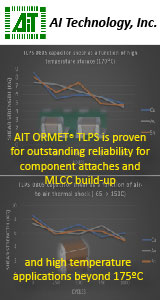| Sponsor |

|
Thermally Conductive Epoxy
Master Bond Supreme 11AOHTLP is a two component adhesive featuring thermal conductivity and electrical insulation for high performance bonding, sealing and coating.
Master Bond
|
|
| Sponsor |

|
Electrically Conductive Die Attach Epoxy
Master Bond EP17HTS-DA is a silver filled, die attach adhesive that withstands high temperatures and passes MIL-STD-883J thermal stability requirements.
Master Bond
|
|
Modern Methods of PCB Depanelization with a Focus on Low Impact Depanelization
It is easier and more economical to manufacture multiple assemblies simultaneously on a larger panel and then singularize them once they’ve been populated.
Analysis Lab
DOWNLOAD
|
Authored By:
Max Bernard, Yoshito Kanayama, Steven Yukutake, and Michelle Ogihara
Seika Machinery, Inc.
CA, USA
Summary
Individual circuit card assemblies have been getting smaller and more densely populated. As such the manufacturing community has recognized that it is easier and more economical to manufacture multiple assemblies simultaneously on a larger panel and then singularize them once they’ve been populated. PCB depaneling is that critical process in the manufacturing of PCBs that involves removing the individual assemblies from the larger panel. This step is necessary to increase production efficiency, ensure board quality and functionality, and reduce waste. Unfortunately, this penultimate process is often an overlooked one and can result in damage to fragile surface mount components, solder masks, and even the PCB substrate which could ultimately lead to scrapping the entire assembly that we’ve been so meticulous with up to this point.
However simple it may seem, depaneling introduces its own set of complications to the manufacturing process including mechanical stress, dust, debris, and design restrictions. To overcome these challenges, there are several depaneling methods available, each with its own advantages and disadvantages.
In this presentation, we’ll discuss some of the common failures associated with depaneling as well as exploring the various methods of depanelization. The methods we’ll be discussing in further detail are, V-scoring, die cutting, hand breaking, pizza cutters, laser depaneling, and PCB routers. We'll discuss the technical aspects of each method, including their speed, accuracy, and impact on the PCB and components as well as some of the design considerations for the different processes. We’ll also briefly touch on the upfront and ongoing costs associated with each method.
Additionally, we'll showcase the latest trends and technologies in this field and offer tips on selecting the right depaneling method for your specific application. Whether you're a seasoned professional or new to PCB production, this presentation will provide valuable insights into this essential process. So, sit back, relax, and let's dive into the world of PCB depaneling!
Conclusions
While fully automated depanelers with robotic loaders sounds like an awesome solution it may be completely overkill for a project that would be acceptable with v-score and hand brake and for that reason you’ll have to decide which process or combination of processes is right for each product. Thankfully there are many different options to choose from when it comes to depaneling and ultimately, you’ll have to weigh the pros and cons of each method against the cost and see how much strain your components will tolerate and how much stress you’re willing to put up with!
Initially Published in the SMTA Proceedings
|
Free Newsletter Subscription
Circuitnet is built for professionals who bear the responsibility of looking ahead, imagining the future, and preparing for it.
Insert Your Email Address
|
| Sponsor |

|
Our Solutions
Discover Essegi Automation's modular solutions: flexible hardware and software seamlessly integrated into SMT and THT environments.
Essegi Automation
|
|
|
